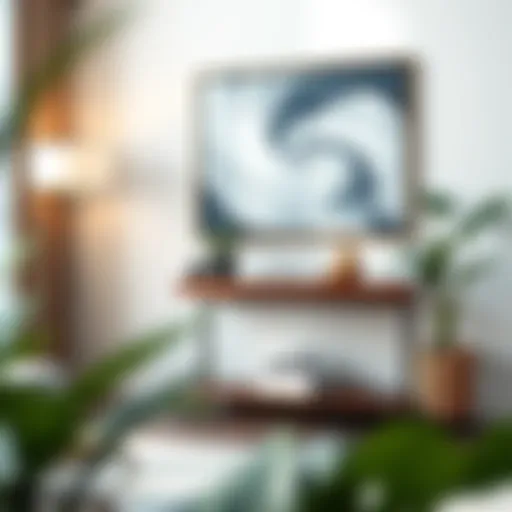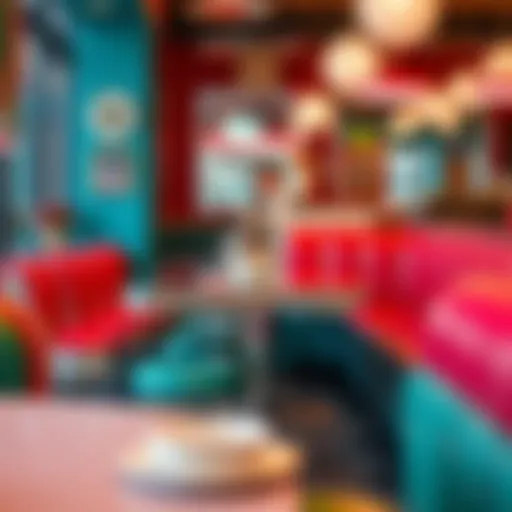Hallway Curtains: Design, Installation, and Care Guide


Intro
Hallways often serve as the arteries of the home, guiding guests from room to room. Yet, they can sometimes feel a bit like a blank canvas. This is where hallway curtains come into play. Not only do they provide function, such as privacy and light control, but they also have the potential to transform a hallway into a visually engaging element of your home’s interior.
Consider how hallway curtains can alter the ambiance. With carefully chosen fabrics and designs, they can evoke warmth, elegance, or even a modern chic vibe. This guide will take you through the maze of options available, ensuring that you not only understand the role of hallway curtains but also learn how to make them work harmoniously within your home.
Furniture Design Styles
Overview of Popular Styles
When considering hallway curtains, one must first look at the overarching furniture design styles that dominate the space. Each style brings its own flavor, influencing color, fabric, and pattern choices in curtains.
- Minimalist: Characterized by clean lines and a lack of clutter, minimalist designs benefit from sheer, light-colored curtains that allow natural light to flow while adding a touch of softness. Think airy linens in off-white.
- Traditional: A classic style that often leans on rich fabrics and heavier prints, traditional curtains often incorporate materials like damask or brocade. Deep burgundies or navy blues paired with florals capture the essence of this aesthetic.
- Contemporary: This style flips the script, favoring bold patterns and unexpected materials. Curtains in this realm might feature geometric prints or metallic fabrics that serve as eye-catching statements.
How to Mix and Match Styles
There’s no rule etched in stone that says your hallway must adhere to a single style. In fact, mixing and matching can create a unique atmosphere. When combining design elements, consider the following:
- Color Harmony: Choose a palette that ties various styles together, ensuring that the hues resonate throughout the space.
- Textural Contrast: Pair a soft, flowing fabric with sharper lines or angular decor for a balanced look.
- Pattern Integration: Be cautious here; too many patterns can overwhelm. Instead, select one statement curtain design to anchor your hallway.
“A well-designed space is not just about what's in it; it's also about what’s not in it.” – Anon.
Practical Tips for Homeowners
Essential Buying Tips
When venturing out to purchase hallway curtains, you’d want to keep some practical tips in mind:
- Measure First: Always take measurements of your space before committing to a curtain style. Knowing the height and width is essential for a proper fit.
- Fabric Matters: Depending on the hall's exposure to light, choose a fabric that balances durability with the desired light filtering. For instance, heavier fabrics like velvet work well in darker spaces, while lighter materials suit sun-kissed areas.
- Rings vs. Rods: The way you choose to hang your curtains can affect their look. Rings offer a more elegant drape, while rods can provide a more relaxed effect.
Maintenance and Care Guidelines
Maintaining your hallway curtains doesn’t need to be a chore. Consider these straightforward care guidelines:
- Regular Dusting: A periodic shake or a gentle vacuum with a brush attachment will help keep them looking fresh.
- Washing: Check the care label. Many fabrics can be machine washed on a gentle cycle but others may require dry cleaning.
- Seasonal Rotation: To prolong their lifespan and keep the aesthetic feeling fresh, consider rotating curtains based on seasons.
As you embrace the world of hallway curtains, remember that they are not merely functional items. Instead, they embody a chance to express your style, add character to your space, and create a pleasant transition from one room to another. For additional insights, you might want to read further from Wikipedia or browse through Reddit discussions.
The Role of Hallway Curtains in Home Design
Hallway curtains play a critical role in home design, serving both functional and aesthetic purposes. They are often the unsung heroes of interior decoration, subtly affecting the overall ambiance and flow of a space. By understanding how hallway curtains can redefine a home’s aesthetic, homeowners and designers can create environments that are not only visually pleasing but also highly functional. This section highlights various elements, benefits, and considerations integral to the selection and use of hallway curtains.
Defining Space Through Textiles
In many homes, hallways can feel like an afterthought—a mere passageway rather than a part of the living experience. However, the clever use of hallway curtains can transform these areas by defining spatial boundaries. Whether it’s a soft drape parting two distinct living areas or a sheer panel that separates the hallway from a bright entryway, curtains can impart a sense of intimacy.
When envisioning a stretch of space that feels cold or too vast, introducing fabric can soften the surroundings and create a welcoming atmosphere. Thick, rich fabrics can lend a sense of luxury, while lighter materials can open up the area, allowing light to filter through but still offering a division. As the saying goes, "the devil is in the details," and those details are often textiles that can change how we perceive spaces.
"Curtains can alter not just how a space looks, but also how it feels. They can invite coziness or promote openness, all depending on choice and placement."
Balancing Privacy and Light
Privacy is a key consideration in hallway design, particularly in urban settings where neighbors are closer than one might prefer. Curtains serve as an effective barrier, allowing for privacy without sacrificing natural light. This dual functionality is vital, especially in a hallway, where ample light is essential for both safety and aesthetics.
For instance, sheer curtains can maintain a room’s brightness while providing concealment from view. This way, one can enjoy an airy feel while ensuring that outsiders cannot easily peer in. On the other hand, heavier curtains can wrap spaces in warmth and intimacy, ideal for homes where guests or family members frequently traverse the corridors.
When selecting curtains, it's essential to think about their ability to toggle between openness and seclusion. The perfect balance can be achieved through layering; think light sheer panels behind heavier drapes, granting the ability to adjust light and privacy as needed. The tactile quality of fabrics can enhance this balance and add a significant dimension to hallway spaces.
Ultimately, hallway curtains can do much more than simply hang—they shape our experiences within our homes, guiding perceptions of space, light, and privacy. They are a simple yet profound element that can significantly enhance a home’s design aesthetics and functionality.
Design Considerations for Hallway Curtains
Design considerations for hallway curtains are pivotal, influencing how a space feels and functions. Choosing the right curtains goes beyond aesthetics; it's about functionality, comfort, and style all rolled into one. Curtains can define a hallway's character, guiding light and providing a barrier, hence they serve multiple purposes. Homeowners should keep in mind several factors when selecting curtains for these transitional areas.
Choosing the Right Style
Selecting a style for hallway curtains can make or break the visual appeal of the space. Below are varying styles explained in detail:
Contemporary
Contemporary curtains are known for their clean lines and minimalistic designs. This modern approach greatly appeals to those leaning towards simplicity and elegance. A key characteristic of contemporary styles is their focus on functionality, combined with the ability to adapt to various environments.
The unique feature of contemporary designs is their versatility—they can easily complement both urban and rustic interiors. However, they may lack the warmth that other styles provide, which some homeowners might find essential for their hallway experience.
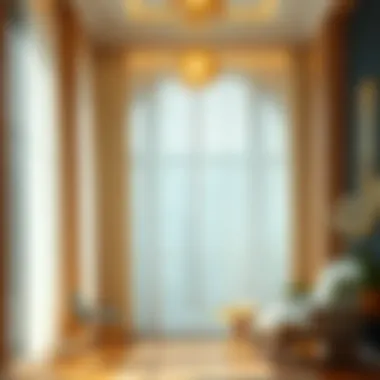

Traditional
Traditional curtains often draw inspiration from historical designs, featuring rich fabrics and patterns. This style adds a classic charm to hallways, making them feel inviting and cultured. A key feature of traditional curtains is their ability to evoke nostalgia while maintaining a sophisticated look.
One advantage of traditional styles is their use of thick materials that provide excellent insulation, thereby making hallways cozier. That said, installing traditional curtains can sometimes overwhelm smaller hallways, making them feel cramped.
Eclectic
Eclectic curtains blend various styles, colors, and patterns into a singular design concept. This approach is perfect for those who want to showcase their personality. A note-worthy characteristic of eclectic designs is their fearless approach to mixing and matching, often incorporating vibrant hues and unique fabrics.
The unique feature here is the ability to create a one-of-a-kind look that is entirely your own. However, the downside is that, if not carefully curated, an eclectic style might result in a visual clutter that could detract from the space rather than enhance it.
Color and Pattern Choices
The color and pattern of hallway curtains steer the mood of the hallway significantly. Choosing wisely can guide light, create illusions of space, or add character to an otherwise plain area.
Neutral Tones
Neutral tones like beige, grey, or soft whites are popular for hallway curtains as they lend a serene backdrop and blend seamlessly with various decor styles. These colors contribute to the overall calmness of the space, ensuring that the hallway never feels charged or overwhelming. A standout feature is their flexibility—they work well with other elements in the house, making them beneficial for maintaining a cohesive look.
On the downside, neutral tones can occasionally lack the character or interest that brighter colors might provide. Thus, one must consider how they fit into the broader design scheme.
Bold Patterns
Bold patterns are a striking choice for homeowners looking to make a statement. Geometric shapes or floral designs can become focal points in a hallway, drawing attention and admiration. The key standout of this approach is its ability to inject vitality into the space, infusing personality.
However, bold patterns can also be a double-edged sword. If overused or not matched correctly with other decor elements, they may overpower a small or minimally designed hallway.
Subtle Textures
Subtle textures provide an understated elegance that enhances the visual interest of a hallway without overwhelming the senses. Fabrics like linen or silk can offer a soft touch that adds depth. The major advantage here is the ability to add a tactile quality to the space while still maintaining a refined look.
Nevertheless, subtle textures can sometimes be difficult to maintain, especially in high-traffic areas, as they may show wear and tear more readily than other materials.
Important Consideration: While choosing curtains for hallways, consider both immediate aesthetics and long-term maintenance needs. The right choice can elevate not just the atmosphere but also the longevity of your decor.
Materials Used in Hallway Curtains
When it comes to hallway curtains, the fabric choice can make or break the overall aesthetic. The materials used shape not only the look but also the functionality of the curtains. Understanding the differences among fabric types enables designers, homeowners, and decorators to make informed decisions that suit their space's needs and styles.
Fabric Options
Cotton
Cotton is a classic fabric for hallway curtains due to its versatility and softness. This material is of goodness for rooms that welcome lots of light, as light cotton allows for sheer options that can gently filter sunlight. Furthermore, it’s easy to care for; a simple machine wash does the job, making it a practical choice for everyday use. The breathability of cotton helps in maintaining a comfortable temperature in various climates.
However, it’s essential to note that cotton can wrinkle and shrink if not treated appropriately. The lightweight nature also means it might not provide as much insulation as heavier fabrics. Overall, its affordability and relative ease of maintenance make it a popular fabric in household choices.
Linen
Linen is another noteworthy fabric for hallway curtains; it boasts natural fibers that add a touch of elegance to any space. Renowned for its durability, linen ages beautifully and can develop a desirable texture over time. This fabric tends to drape quite well, creating an appealing visual flow in the hallway.
One key selling point of linen is its moisture-wicking properties, which make it perfect for humid areas. However, it isn't the most budget-friendly option and typically requires dry cleaning to maintain its integrity. Despite its higher cost, linen's timeless aesthetic and sustainability often sway buyers toward this fabric.
Polyester
In the realm of hallway curtains, polyester fabric stands out for its resilience and low upkeep. It resists wrinkles and fading, making it a practical option for high-traffic areas. Polyester curtains can mimic more expensive materials while being significantly less costly, which is a big plus for DIYers looking to achieve luxe looks without the hefty price tag.
Although polyester is not as breathable as cotton or linen, it is easy to clean and often washable in a machine, appealing to busy households. Still, some may find its synthetic texture less inviting compared to natural fibers. Balancing budget with style? Polyester often fits the bill.
Durability vs. Aesthetics
When balancing durability and aesthetics, a delicate line exists. The design choices can lean heavily on function, yet aesthetics must not be overlooked. Think about how often the curtains will be used and how much wear they will encounter. A fabric that looks stunning might not withstand the test of time in a busy hallway, whereas a more functional fabric may lack that desirable aesthetic.
"Choosing the right material is like finding a partner; it requires balance. You want something that looks good and stands the test of time."
Draw up a list of your priorities. If you have small children or pets, durable materials such as polyester may be more appealing, despite the visuals. On the other hand, if you're after that enchanting look, you might consider the beauty of linen, accepting that it may need a little extra care. Ultimately, selecting hallway curtains that serve both aesthetic and practical needs leads to a more satisfying and cohesive home environment.
Installation Techniques for Hallway Curtains
Installing hallway curtains might seem straightforward, but the process can profoundly impact the curtain’s functionality and aesthetic. The right installation technique not only ensures the curtains hang beautifully but also enhances the overall look of the hallway. Such techniques provide a way to integrate curtains with the surrounding interior design, creating fluid transitions between spaces. The following sections break down the key steps involved in achieving a perfect installation.
Measuring for a Perfect Fit
Precision is everything when it comes to measuring for hallway curtains. An accurate measurement guarantees that the curtains don’t end up too short or too long, which can undermine the elegance you are aiming for. Here’s a simple guide to measuring:
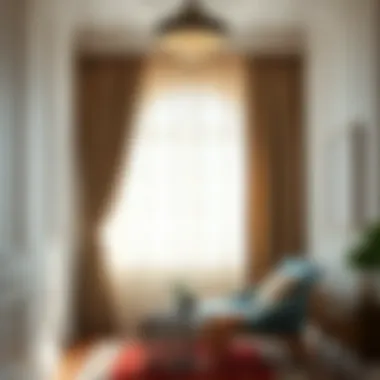

- Decide where to mount the curtain rod: Curtains can be hung right at the ceiling or above the doorway. Higher placements can make the hallway appear taller.
- Measure the width of the space: Use a tape measure to determine how wide your space is. You typically want the rod to extend beyond the width of the opening by about 4 to 10 inches on each side. This creates a fuller look when the curtains are open.
- Determine the length: Depending on the desired style—whether the curtains graze the floor or fall just above—it’s critical to get the right length. Measure from the mounting point down to where you want the curtain to end.
Taking these measurements correctly can save a lot of heartache down the line when the time comes to install the curtains.
Hanging Methods
Rod Pocket
Rod pocket curtains are a classic option that many homeowners adore. The unique feature of these curtains is that they have a sewn-in pocket at the top where the curtain rod slides through. This uncomplicated method gives the top of the curtains a soft, gathered look, which can be quite appealing in a residential setting.
The primary advantage of rod pocket curtains is their simplicity. Without additional hardware, they provide a clean, unstructured appearance, which synergizes beautifully with informal or traditional decors. However, they can limit the ease of opening and closing the curtains — once hung, they're generally meant to stay in place unless you pull them aside manually. So, if accessibility is a priority, consider this when choosing.
Tab Top
Tab top curtains feature loops sewn into the fabric that drape over the curtain rod. This method introduces a more casual vibe to your hallway, showcasing the beauty and texture of the fabric itself. The advantage here is the stylish appearance created by the tabs, which allow the fabric to hang down with a natural fall.
These curtains also provide ease of movement, as the tabs glide smoothly over the rod. However, one should be aware that tab tops may not be the best fit for all styles; for contemporary or minimalist homes, they might not deliver the sophistication you’re looking for.
Eyelet
Eyelet curtains are distinguished by their metal grommets that reinforce the holes for the curtain rod. This style offers a modern touch and is incredibly easy to install. With eyelet curtains, the fabric hangs straight, producing a sleek profile that many find appealing in contemporary design.
The robust structure of the eyelets allows the curtains to slide along the rod effortlessly, making them a practical choice for high-traffic areas. Nevertheless, their geometric edge might contrast with softer, more traditional interiors. Assess your decor first to ensure a seamless integration.
In the world of hallway curtains, the installation method can significantly affect both functionality and style. Each method has its pros and cons, so choose based on both aesthetics and practical needs.
In summary, mastering the techniques of measuring and hanging hallway curtains is essential for a polished and professional finish. Each method—from rod pockets to eyelets—comes with its own merits. As you plan your installation, consider how the chosen method will harmonize with the rest of your design.
Caring for Hallway Curtains
Maintaining hallway curtains is essential for keeping them looking fresh and enhancing their overall lifespan. Curtains often serve as both functional and aesthetic components of a home, providing privacy while also complementing the interior decor. Understanding how to care for them not only prolongs their usability but also ensures that they remain an integral part of the home’s design.
Cleaning Guidelines
Machine Washing
Machine washing is one of the most common methods for cleaning hallway curtains, and for good reason. It is generally straightforward and saves time. The ease of tossing curtains into a washing machine cannot be overstated, especially for those who prefer quick and convenient options. The key characteristic of machine washing lies in its efficiency; it allows homeowners to clean curtains regularly without too much fuss.
When handling this method, it’s critical to check the care labels first. Some fabrics, like cotton, easily withstand machine washing, while others, like silk, might shrink or lose their luster. The unique feature of this method is that you can add specific detergents designed for curtains, which can help preserve their color and texture.
However, there are disadvantages. Not all curtains can hold up well in a wash cycle—some may fray or fade. Hence, if you choose this route, consider using a gentle cycle and cold water, and always air dry instead of placing them in the dryer. This approach can ensure that your curtains remain in prime condition.
Dry Cleaning
Dry cleaning often becomes the favored option for delicate and high-maintenance fabrics. This method is beneficial, particularly for curtains made of materials such as wool or those that boast intricate embroidery. The main advantage of dry cleaning is that it helps maintain the original shape and coloration of the fabric without the risk of damage that comes with water exposure.
A unique feature of dry cleaning is the use of solvent rather than water, which can effectively remove stains while preserving fabric integrity. It’s particularly prudent for curtains that contain linings or are heavy in embellishments—as these might not survive a wash cycle.
On the downside, dry cleaning can be more expensive and time-consuming compared to machine washing. It's also essential to find a reputable cleaner who specializes in delicate fabrics to avoid any mishaps.
Maintaining Fabric Quality
To prolong the life of hallway curtains, it's crucial to focus on maintaining fabric quality. Regular inspections for dust buildup or potential damage should be routine. A simple approach is to vacuum curtains lightly with a brush attachment to remove allergens and dust particles. This not only keeps them looking good but also contributes positively to indoor air quality.
Additionally, the placement and exposure to direct sunlight can affect the fabric. If curtains are frequently in the sun, consider employing UV-blocking liners or adjusting their position to mitigate fading. Another strategy is to rotate them occasionally, allowing a more even wear pattern.
Ultimately, investing time in proper care and maintenance can significantly enhance the aesthetics and functionality of hallway curtains in your home.
Trends in Hallway Curtain Designs
The design landscape is ever-evolving, and hallway curtains are no exception to this reality. Understanding current trends in hallway curtain designs helps homeowners and designers create spaces that resonate with modern aesthetics while serving practical purposes. This section focuses on two noteworthy trends: sustainable fabrics and smart textiles. These elements not only address the needs of contemporary decor but also highlight a growing awareness of environmental impact and technology integration.
Sustainable Fabrics
In recent years, the momentum for sustainable fabrics has taken the home decor industry by storm. Homeowners are increasingly aware of the environmental consequences of their choices. Fabrics like organic cotton, recycled polyester, and linen are making their mark in hallway designs, offering an eco-friendly touch to interior spaces. Choosing sustainable materials doesn't just reflect a commitment to the planet; it also brings unique texture and character into the home.
- Benefits of Sustainable Fabrics:
- Reduces environmental impact by minimizing waste.
- Often hypoallergenic, making them suitable for sensitive individuals.
- Longer lifespan which normally means better value over time.
When selecting sustainable options, it's crucial to ensure that they are not just marketed as such but truly come from ethical sources. A little research goes a long way in understanding the fabric's origin and the production processes involved. As a homeowner or designer, integrating sustainable fabrics into hallway designs can enhance the ambiance while signaling a commitment to healthier living.
Smart Textiles
Smart textiles are stepping beyond mere functionality with innovative features that adapt to various living conditions. These fabrics can change their shape, maintain temperatures, or even respond to environmental stimuli. For example, there are curtains that can automatically adjust their opacity based on the amount of natural light filtering in. This not only offers convenience but also allows homeowners to control their privacy and energy consumption effectively.
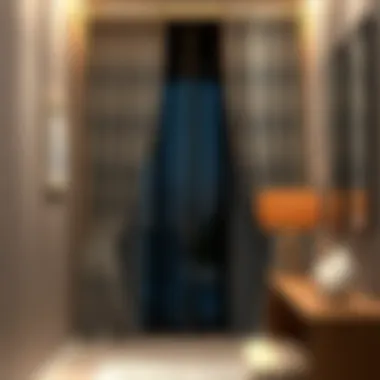

- Key Characteristics of Smart Textiles:
- Temperature Regulation: Some fabrics can keep spaces cooler in summer and warmer in winter.
- Light Control: Responsive to sunlight, they can help reduce solar glare without the need for additional drapery.
- Easy Maintenance: Many smart textiles are engineered to be stain-resistant and can be machine washed.
Incorporating smart textiles into hallway curtain designs represents a significant shift towards tech-savvy homes. Forward-thinking designers can harness these innovations to create spaces that not only look great but also function seamlessly.
"The weaving of technology into textiles opens doors for innovative interior designs that prioritize efficiency and style."
Common Mistakes in Choosing Hallway Curtains
When it comes to hallway curtains, many individuals might leap before they look, leading to choices that could ultimately hinder their home’s aesthetics and functionality. Understanding common pitfalls can save time, money, and perhaps even a few headaches down the line. This section zeroes in on two major blunders—ignoring spatial dynamics and overlooking maintenance needs. Navigating these issues means that your curtains not only look splendid but also serve their purpose effectively.
Ignoring Spatial Dynamics
Space is a three-dimensional puzzle; it’s essential to keep this in mind when selecting hallway curtains. Curtains can influence how a hallway feels and flows. One of the mistakes frequently made is hanging curtains without properly measuring or considering the space’s natural dynamics. For instance, if your hallway already feels cramped, adding thick, heavy fabric might just make it feel even smaller.
When selecting curtains, remember:
- Length Matters: Floor-length curtains can create a sense of elegance, but in narrow hallways, shorter curtains may offer a more open vibe.
- Width Counts: Curtains that are too wide can block passage or cramp the hallway’s feel.
- Placement Plan: Hanging curtains too high or too low can disrupt visual continuity. For a balanced look, aim for a height that complements your ceiling.
Keeping spatial dynamics in check is about respecting the flow and function of the space. Thoughtful placement and sizing ensure that you enhance rather than hinder movement through your home.
Overlooking Maintenance Needs
Another misstep often made involves neglecting the care and upkeep of hallway curtains. Selecting curtains that dazzled during the first glance can sometimes lead to complications down the line, especially if they aren't practical for everyday life. Consider fabrics and cleaning methods before settling on a design.
When picking curtains with maintenance in mind, ask yourself:
- Can It Be Washed?: If you choose a delicate fabric, like silk or a complex blend, know that those may require dry cleaning—a hassle if you’re looking for easy upkeep.
- Dust and Allergens: Hallways can be dust magnets. Curtains that attract and hold debris might not be the best choice. Opt for materials that resist dust or are easy to clean.
- Color Fastness: Some vibrant colors may fade in time, especially in bright hallways. Determine if you want to deal with such issues down the road.
By being aware of these maintenance needs from the get-go, you ensure your curtains will not only look amazing but also last long while remaining easy to manage.
"Choosing the right curtains in consideration of space and maintenance is as important as the colors and patterns you select. Be wise in your choices and the dividends will be plentiful!"
With thoughtful awareness of these common mistakes, your approach to selecting hallway curtains can be a fruitful endeavor, leading to decisions that blend style with functionality.
Inspirational Hallway Curtain Ideas
Hallway curtains serve a greater purpose than merely acting as a barrier or decorative element. They can transform a mundane corridor into a visually striking passageway. This section highlights key ideas for utilizing hallway curtains effectively, weaving creativity with practicality to not only enhance aesthetics but also improve functionality in your living space.
Using Curtains as a Room Divider
One innovative use for hallway curtains is as room dividers. This method allows you to segment larger spaces without the cost or permanence of walls. Imagine a multifunctional area where different activities coalesce: a home office that can be separated from an adjacent space, offering quiet when needed. Curtains, selected to match or contrast with the surroundings, can offer an elegant solution.
When choosing curtains for this purpose, consider:
- Height and Length: Ensure the curtains touch the floor for a polished look. This adds drama and a sense of separation.
- Opacity: Use sheer fabrics to allow light while maintaining a sense of privacy, or go for heavier materials for a more defined separation.
- Patterns and Colors: Vibrant or patterned fabrics can add a splash of personality, transforming the ambiance. A lively print could energize a workspace, while soft, muted tones can create a cozy reading nook.
All in all, using curtains to divide rooms is both functional and flexible, allowing for alternate uses of space without the commitment of building walls.
Layering with Other Textiles
Layering is a stylish way to enrich the visual texture of a hallway. By combining curtains with other fabrics, such as throw pillows or rugs, you can create a cohesive yet dynamic look. For instance, draping a lightweight curtain over a heavier fabric can add depth and warmth, inviting the eye to explore.
When approaching layering, think about the following elements:
- Texture Variety: Different textures can create a tactile experience; mixing soft cotton with nifty linen or luxurious velvet can enhance interest.
- Color Coordination: Instead of matching everything, consider contrasting colors that complement each other. A bold red curtain can pop against gentle greens or grays, creating a lively yet harmonious atmosphere.
- Functional Pairing: Mix curtains with functionality in mind. For example, pairing sheer curtains with heavier drapes allows you to control light levels easily while adding warmth.
"Layering textiles not only demonstrates a nuanced understanding of design but also imbues your space with a depth that is visually engaging."
To wrap it up, both using curtains as room dividers and layering with different textiles are powerful design strategies that can elevate the presence of your hallway. They bring versatility, style, and practicality, making your home not just a place to live, but a carefully curated space that reflects your personality.
The Future of Hallway Curtains
As we gaze into the horizon of home decor, hallway curtains are likely to evolve significantly, reflecting both technological advancements and changing aesthetic values. This is not only about hanging fabric on a rail—it's about how these elements can transform a space functionally and visually. The future of hallway curtains holds a lot of promise, with innovations aimed at enhancing user experience, intuitive designs, and heightened adaptability to modern living scenarios.
Integration with Smart Home Systems
The incorporation of smart home technology into hallway curtains signifies a major shift in the way we interact with our living spaces. Imagine curtains that open and close automatically based on the time of day or lighting conditions. With smart sensors, homeowners can regulate the amount of natural light entering their hallways, ensuring that spaces remain bright during the day and private at night.
What’s more, several smart curtain systems now allow integration with mobile applications, which can make life more convenient than ever. Homeowners can control their curtains from their smartphones, tailoring light and privacy preferences without getting up from the couch. This feature not only brings comfort but also energy efficiency as it can help maintain room temperature by regulating sunlight exposure.
"Automation in our living spaces opens doors to new levels of customization and control."
—Home Tech Expert
Trends in Minimalism
Minimalism has taken a stronghold in interior design, characterized by clean lines, an uncluttered look, and functionality. Hallway curtains are no exception. The future may see a rise in simple yet elegant curtain designs that complement minimalist themes. Think of fabrics with subtle textures or neutral colors that blend seamlessly with the walls, creating an illusion of space rather than drawing attention.
Homeowners might also gravitate towards sheer materials that provide privacy without compromising light. This trend allows for airy, spacious hallways that feel open and inviting. Additionally, as people continue to downsize and declutter, hallway curtains that serve dual purposes, like acting as room dividers or offering some storage capabilities, can enhance minimalistic designs.
In summary, as we transition into an era of smart living and minimalistic aesthetics, hallway curtains will likely not just serve a decorative purpose, but also adapt to practical needs, helping to define spaces while marrying function with form.

